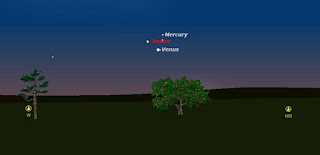An interesting stellar conjunction is about to happen, starting from 20th of may until the 27th of May 2013. Jupiter, Venus and Mercury will be close to each other in the west,
immediately after sunset.
Conjunction between two planets are very common and even between three planets are not rare. Conjunction are always a nice sight to watch and no equipment is needed. Look here for photos of a
previous conjunction between Jupiter and Venus and try to think of a great photographs opportunists near your house.
This is what you will see on May 21st. Mercury is only 5 degrees above the horizon and Jupiter is 13. Jupiter is going down and down and Venus and Mercury up. Watch for several nights to see how the planets move.
| Jupiter Venus and Mercury May 21st 2013 |
And here is a real photo from 22-May-2013. Jupiter is in the top, Venus and Mercury in the bottom.
 |
| Jupiter Venus and Mercury 22-May-2013 |
This is the planets position on May 26yh. Mercury is now the highest of the planets.
 |
| Jupiter Venus and Mercury May 21st 2013 |
And a real photo taken by my dear wife Rosalind Eidelheit. As you can see, Rosalind was very lucky to find some seconds with all three planets visible with these many clouds!
 |
| Jupiter Venus and Mercury May 26th 2013 |
And just one day after. Much less clouds!
 |
| Jupiter Venus and Mercury May 27th 2013 |
And another one from the 28th. I like the power lines which look like a musical score - a celestial symphony
 |
| Jupiter Venus and Mercury May 28th 2013 |
Jupiter will continue to go down until it will disappear from the evening sky and become a morning start, while Venus is about to dominate them for the coming months.







